When I was planning my trip to Mongolia, I knew that I wanted to mainly spend my time in the Gobi Desert. I’m drawn to remote cultures and barren landscapes; the Gobi Desert seemed like it would be just what I was looking for.
I have been to about 90% of Asia and there’s one thing that holds constant among all Asian countries; population density. There are so many people in Asia, it’s mind-boggling. This population density contributes to why Asians aren’t as protective of their personal space as Westerners, and they don’t like to queue.
“We all live under the same sky but we don’t have the same horizon”
Konrad Adenauer
However, when arriving in the Gobi Desert Mongolia I was stunned at the emptiness. The country of Mongolia has the lowest population density in the world. I had never experienced emptiness like this before. We’d drive for 100km in the desert and you wouldn’t see another human being; nor a truck or car or motorcycle.
The videos above were taken before smartphones! Sorry for the quality, but you’ll still be able to see what it’s like to travel through the Gobi Desert!
Table of Contents
Where is the Gobi Desert?
The Gobi is the sixth-largest desert in the world and Asia’s 2nd largest. It’s larger than the country of Peru! It spans 2 countries – Mongolia and China. And there are parts of the Great Wall that actually run through it.

Gobi Desert Climate
The Gobi is a rain shadow desert; it’s on the dry side of a mountain range. The mountains block the clouds from releasing their water and force them to rain on the windward side.
The desert is both extremes – hot and cold – with average lows in January reaching −40 °F (−40 °C) and average highs in July climbing to 113 °F (45 °C). The desert only receives an average of 7.6 inches of rainfall per year. However, it also gets some precipitation from its high-altitude areas where you’ll see frost and occasionally snow.
One great thing about a desert is that you can see for miles and miles; the horizon surrounding you like a halo. However, sometimes that pure horizon would be disrupted by rain. The sky was blanketed in grey clouds taunting the Gobi with the look of rain that would never come; Mother Nature is such a tease.
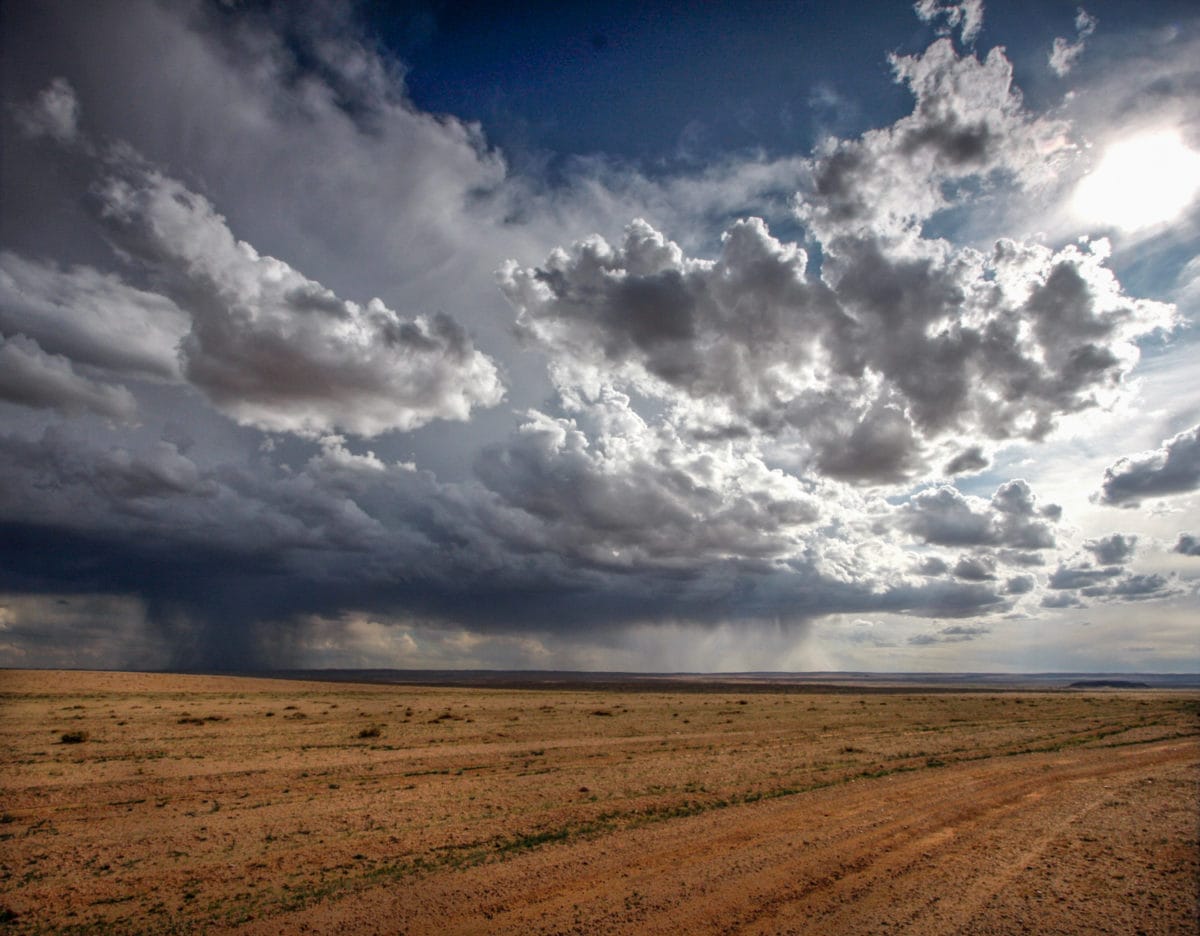
I felt like we existed with a giant force-field around us ensuring the rain clouds stayed always in the distance. This rain force field did provide many fabulous opportunities to watch as the storm took on a life of its own and slowly moved across the desert gathering darkness and power.
Rural and Village Life in the Gobi Desert
You might wonder – Who lives in the Gobi Desert? There is indeed a smattering of life in the Gobi Desert area. There is surprisingly a lot of rural life in the desert. We came across many nomadic herding families who lived in gers in the middle of nowhere. I spent a lot of time staying and interacting with those families to understand their culture and how they lived in such a rough environment.
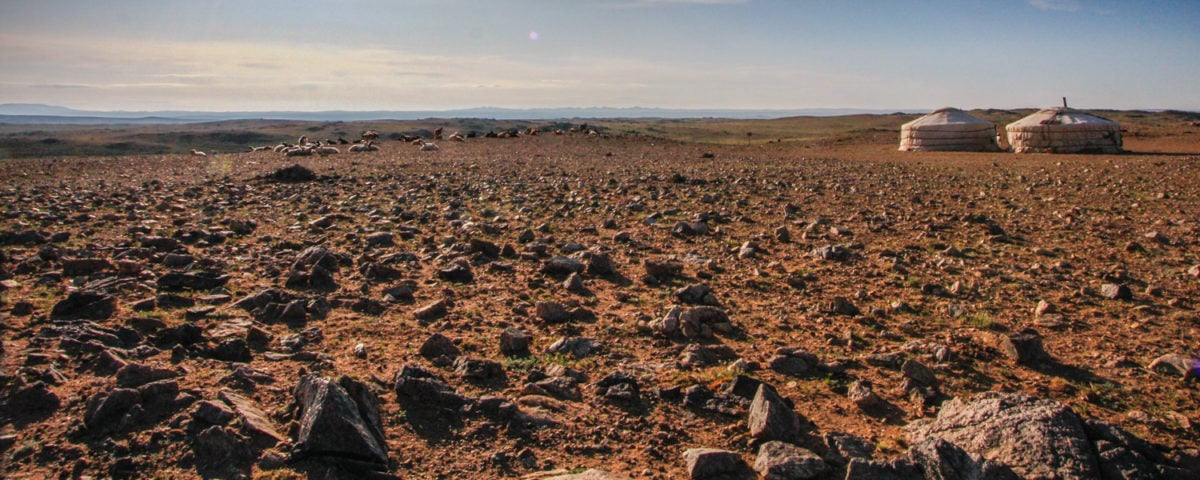
However, if you wanted to shower, then you needed to find a desert village!
Gobi Desert Villages
As dynamic and ever-changing as the Gobi Desert is, the villages in the Gobi are quite a contrast. The only words that would come to mind when I was in a desert village were bleak and uninviting. During my stay in the Gobi, I was overnight in villages for 3 nights. What I thought would be a nice respite from the harshness of ger living turned out to be a bit of a disappointment.
However, being a culture junkie, I found the villages fascinating beyond belief. I always had the same thought run through my head, “Who in their right mind would live here?”
All of my village experiences were similar. I’d arrive in a bleak little village of approximately 1,000 people after a hot, dusty, bumpy drive. There were no trees, nothing green. People claimed their rocky village plot with some sort of house structure AND a ger. Yes, even in the villages everyone still had a ger.
However, unlike in the wide open desert, the village gers were always surrounded by fencing. The fences appeared to be made of a hodgepodge of scrap metal and wood which made it look like a junk yard, not a village.
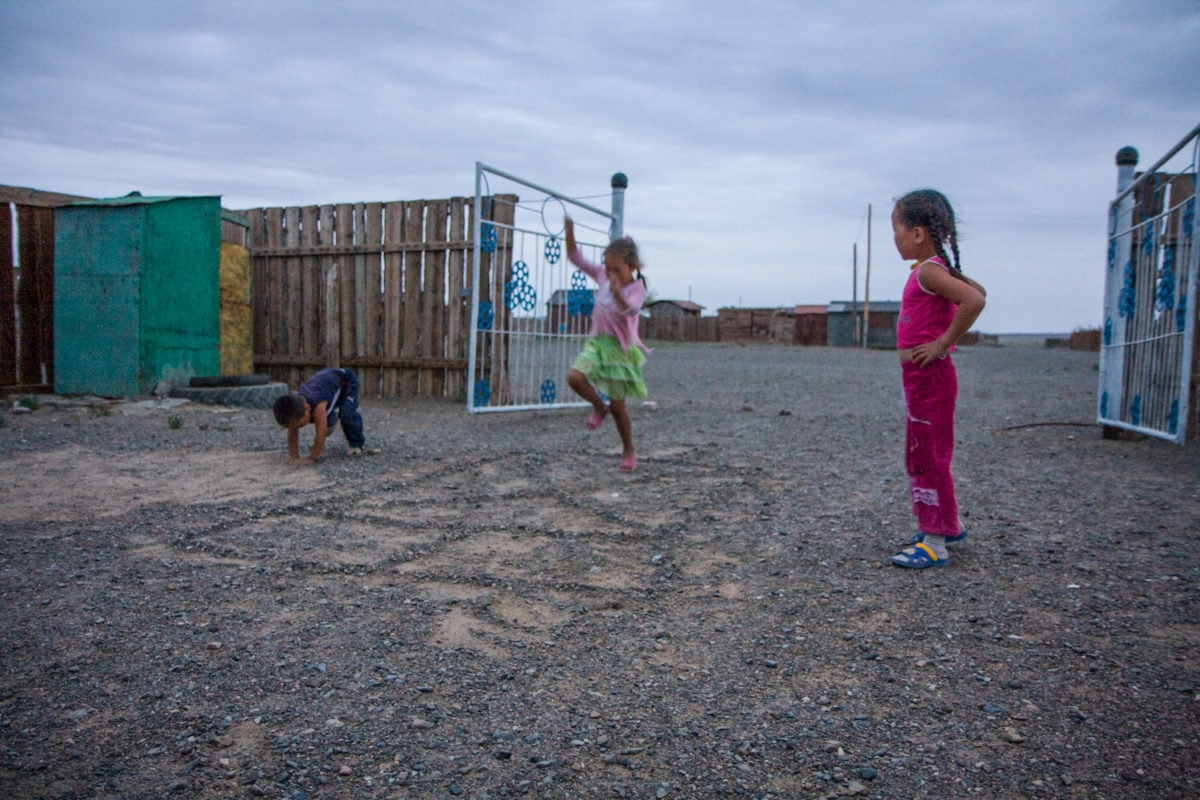
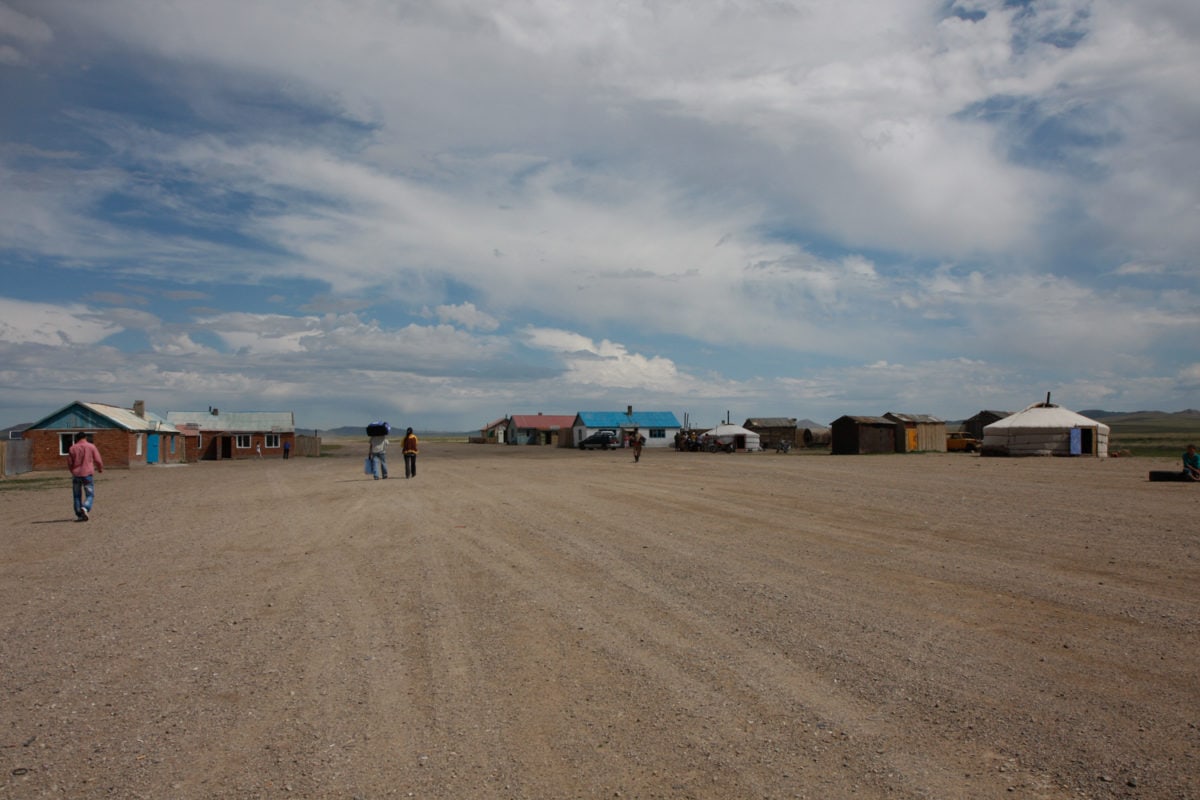
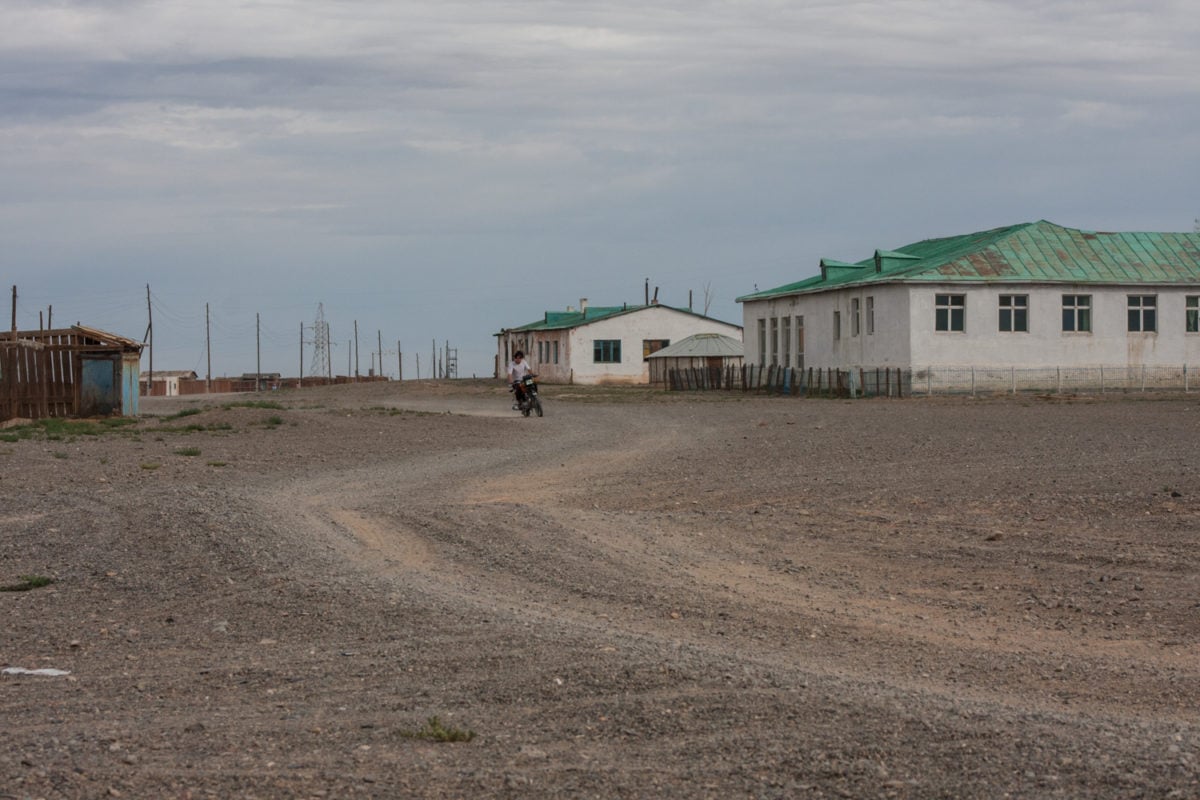
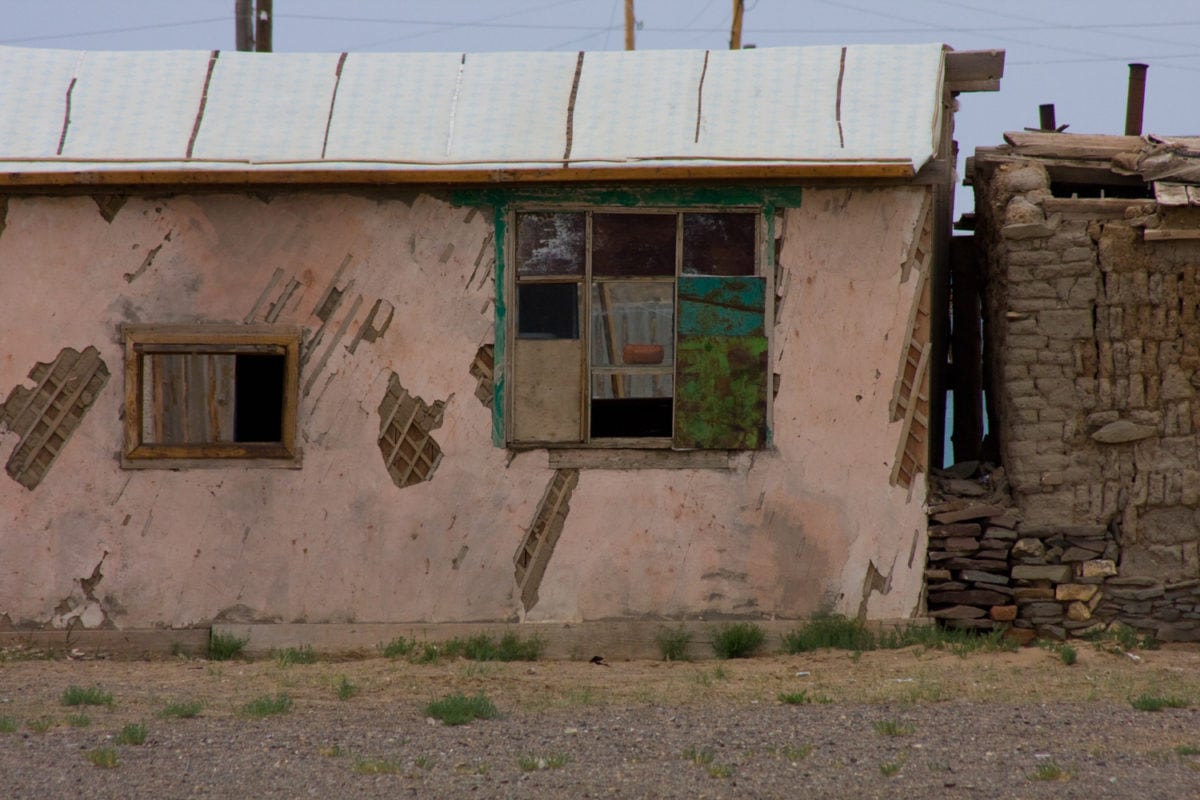
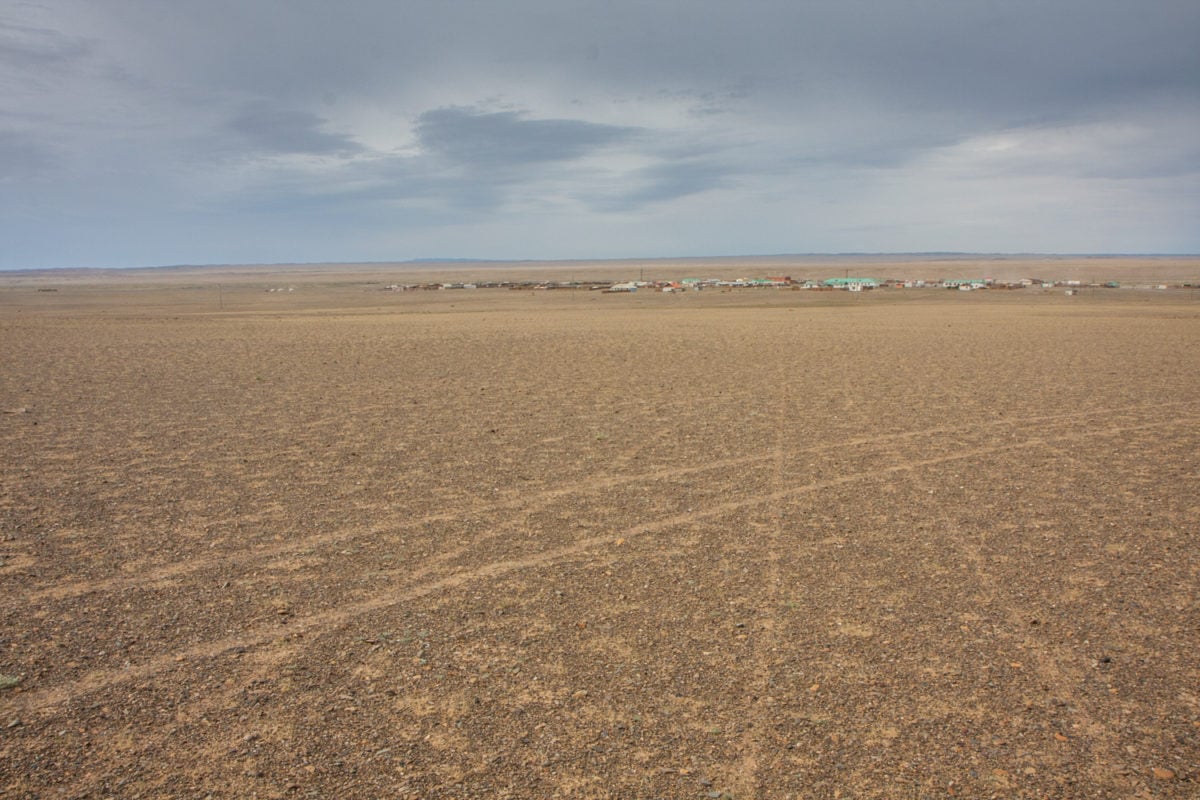
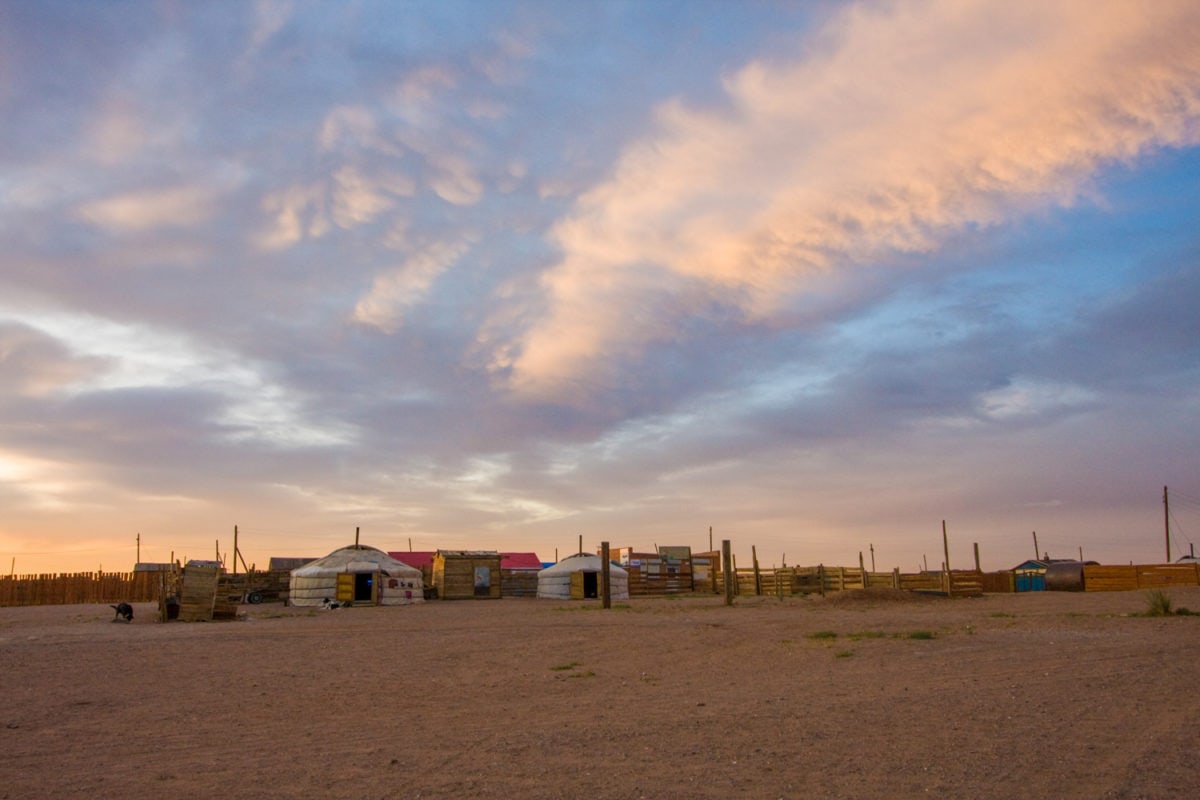
Granted, I don’t know what I was expecting out of the villages in the desert, but it was hard to get any kind of warm feeling about the village.
I found it a strange contrast to the open nomadic way of life where there are no fences or apparent boundaries. The villages appear to be all about exclusion, not inclusion.

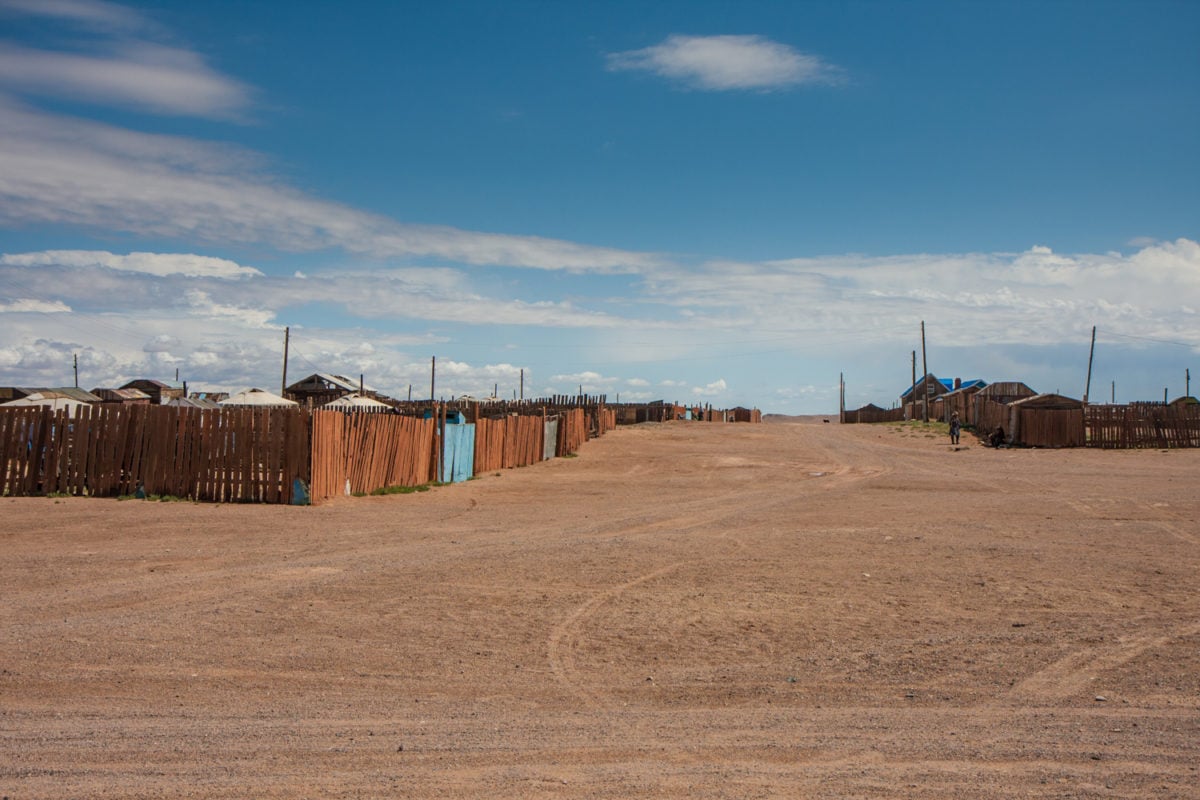
It was hard to find life in these villages. Kids played in the dirt and pebbles; their yards were one giant sandbox. More dogs roamed the street than people, giving a strange science-fiction effect to the villages. Motorcycles sped through once every 20 minutes, and a random car once every 45 minutes. The eerie, ‘what planet am I on’ feeling was heightened due to the lack of grass and trees.
Mongolian food in the Gobi Desert – it’s not what you think
Villages were places you went for a shower!
In the villages, you could pay for a shower at a ‘shower house’ which resembled a Russian woman’s prison. Ok – I really have no idea what a Russian woman’s prison shower looks like…but I swear this is what it would have looked like!
A big, menacing woman took our money and led us into the large open shower room with one shower head. She turned the lever and a tiny little trickle of water came out and dropped to the floor, and the floor seemed to say “thank you.” Without any facial expression, she looked at us, nodded, and left.
Even this ‘barely there’ shower was such a welcome sight after 5 days of dirt, sand, rocks, horses and camel shit. I wouldn’t have cared if that menacing woman would have scrubbed me down as long as I would have been clean in the end!
7 Surprising things I learned about the Gobi Desert
I found the remoteness I was looking for in the Gobi Desert, but I also found many surprises.
1. Where’s the Sand?
When you think of the desert, you think of sand – right? Not so fast, the Gobi isn’t a sandy desert. In fact, in my 12 days there, I saw very little sand (even though my camera sensor would say otherwise evidenced by all the dust particles on my photos that I had to edit!) Instead, there were boulders, rocks, pebbles, and dirt.
There are some large sand dunes, however, you had to travel to find them, they were more of a rarity than the norm. We luckily did travel to the Uush sand dunes; the dunes known for their amazing healing sand (according to the locals who would bury their bodies in it).
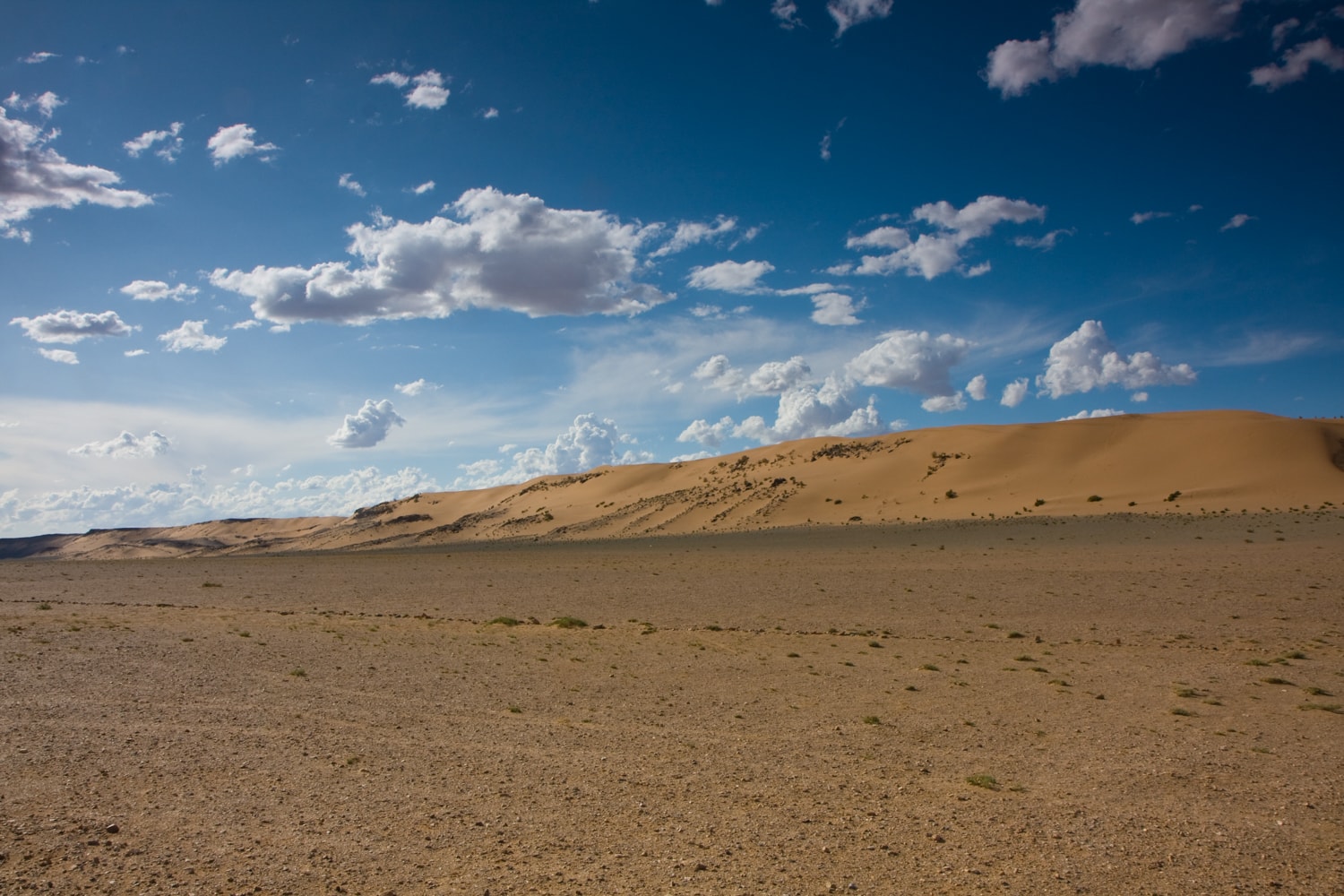


After a long drive through the flat dusty terrain, we finally saw the dunes rise up out of the nothingness. We climbed to the top of the dune, sat down in the fine sand, and took inventory of our surroundings. It was an amazing view from the top; looking down on the flat, hard desert floor.
Seemingly at the last minute he looked at us and said “We go now”, and we all proceeded to race down the huge dune to safety! It was invigorating as we ran into the ger and the sand started whistling past the door and we all took a safe cover. The desert was full of surprises!
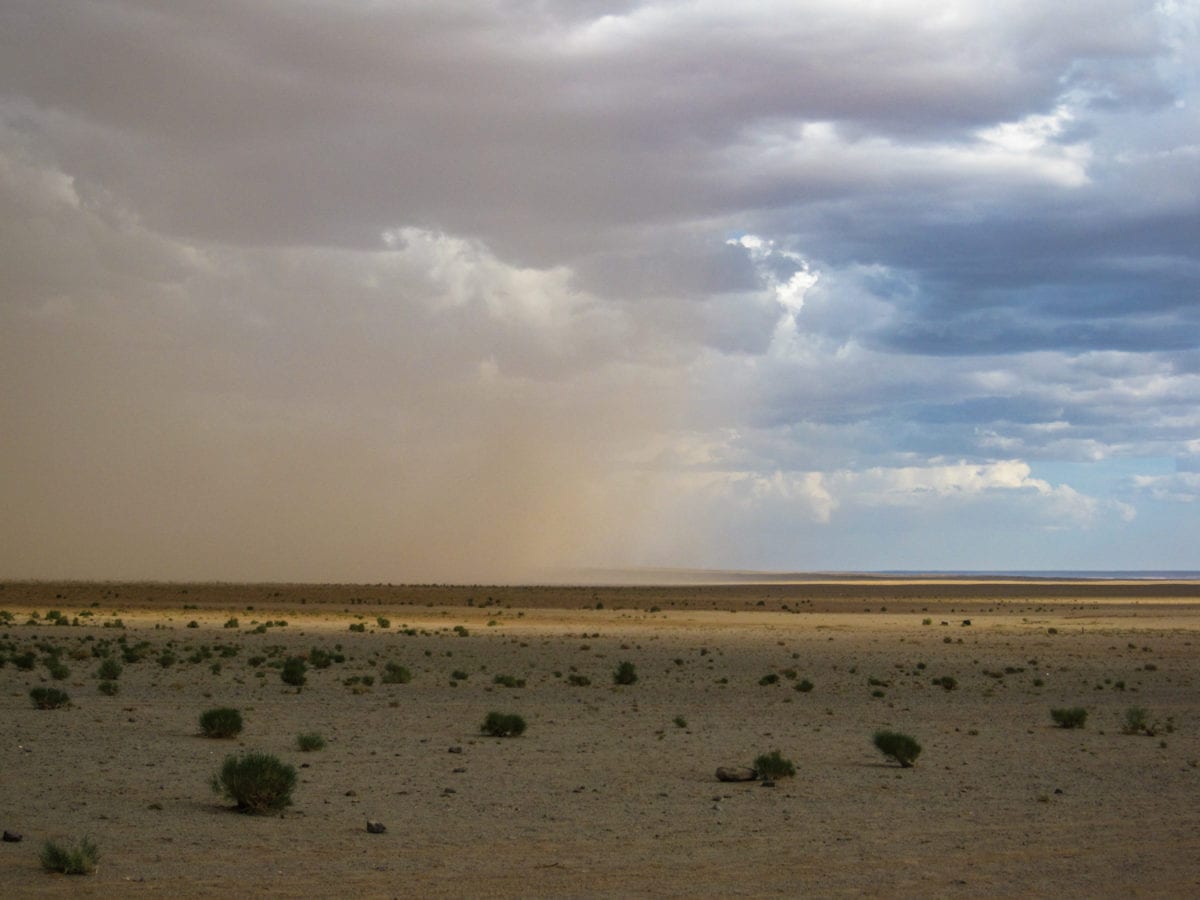
2. The Gobi Desert is a Kaleidoscope of Color and Texture
As we left Ulaanbaatar the terrain changed from rolling green hills with gers puffing out fairy tale smoke to the pebbly brown hills of the Gobi. I saw the last tree I would see in days, and soon the desert colors and landscape seemingly changed as quickly as the turn of a kaleidoscope.
I’d look at the jeep window and see a flat, brown rocky landscape. I’d look up again and see mountains in the distance and then the landscape would be greener with little blades of young grass sprouting up from the parched earth. Next, my eyes would be greeted with a pebbly landscape that looked steely and gray with no sign of life.
Finally, I would stare out my window wondering if I had missed us shooting into orbit somehow; it looked as though we had landed on the moon. This unearthly surface was one of my favorites. Strangely the desert was more colorful than I ever would have imagined if you just paid attention to the details.




3. Gobi Desert Animals Will Keep You Company
Even though the Gobi Desert was isolated, we were never really alone because we were surrounded by animals; camels, horses, goats, sheep, dogs, and yaks. We’d see packs of random camels grazing in the seemingly barren desert. I honestly have no idea what they were grazing on!
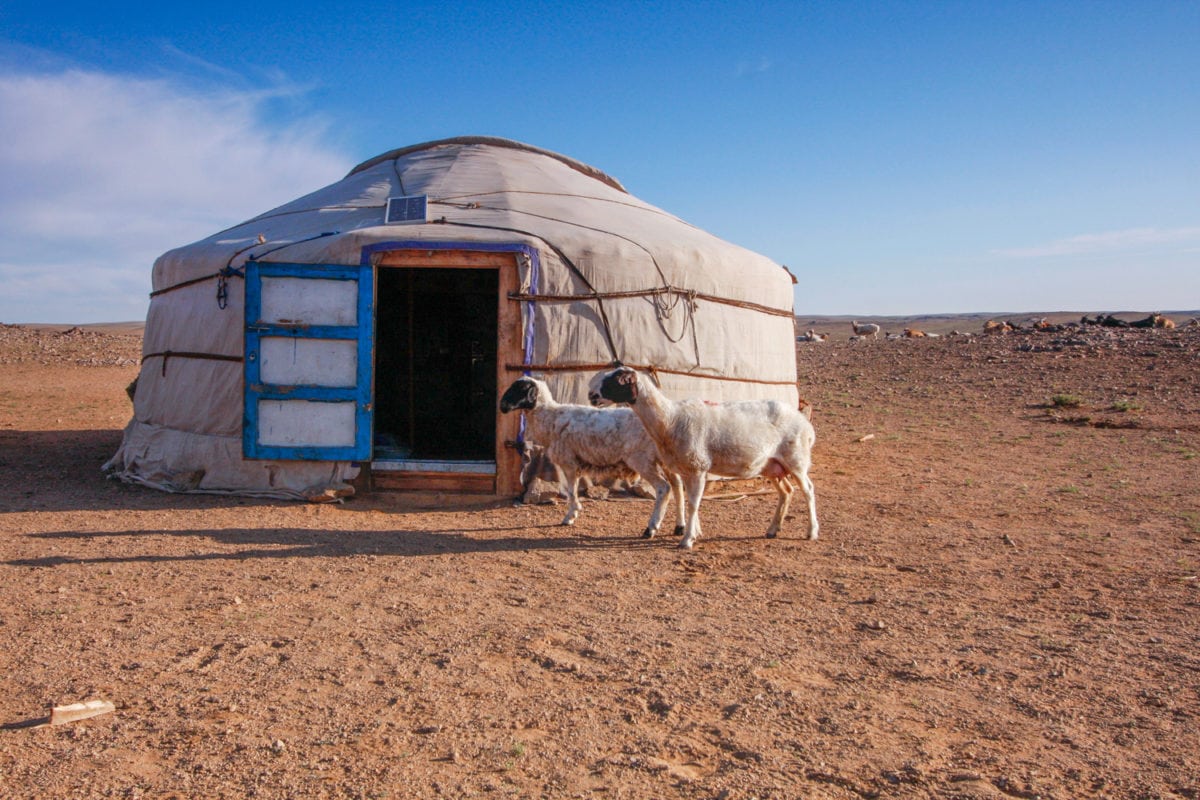
I felt as if we were on safari in South Africa at times; I had memory flashbacks to my time driving in a bumpy jeep through barren land in search of animals.
In the Gobi, it seemed as if the animals would come look at us, and we in turn would look at them. It was as if our shared heartbeats in this empty landscape drew us together.
At one point we came over a small rise in the landscape and suddenly saw a herd of lightning-fast Ibex dart across the vast desert. I yelped in delight as if I had just seen a cheetah! The only thing you could see was little puffs of dust following their trails as they disappeared out of sight as fast as they came into our sight.
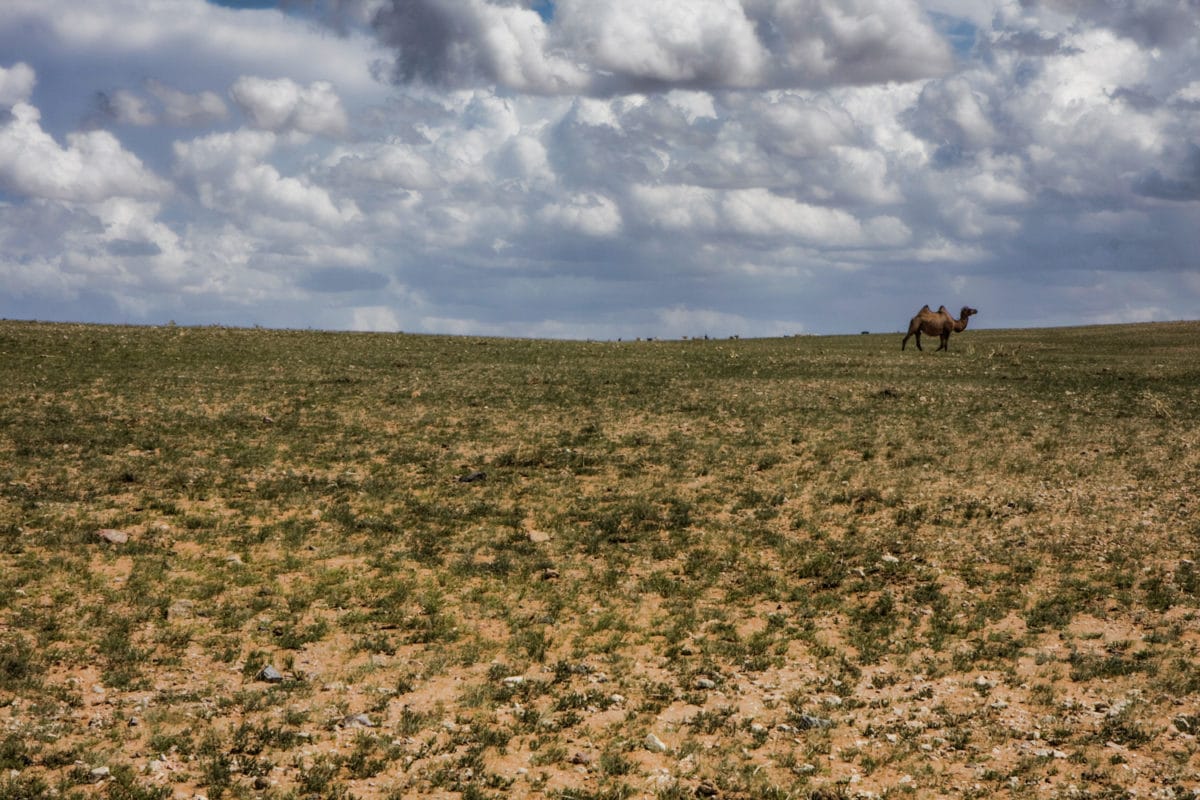
In addition to the unique Ibex sighting, there was another unusual animal in the desert; the camel. It’s important to note that camels in the Gobi desert are actually unique, I was told the Gobi is the only place you’ll find two hump camels in the world which makes them even more rare than elephants!
4. Trees in the Desert
After driving for miles and miles towards the sand dunes, I saw something off in the distance. The little black formations were unusual, but I assumed they were camels or horses milling together in solidarity against the elements.
I kept my eye on the dark odd-shaped spots as we continued to drive closer to them. I rubbed my eyes, still fixated on the spots, realizing that these weren’t animals, nor were they people; they were trees. A strange little clump of trees had sprung up out of the dry, cracked desert floor!
I wondered if I was seeing things; was this indeed a mirage? I had gone days without seeing trees and my brain was surprised to see this one time familiar image again.
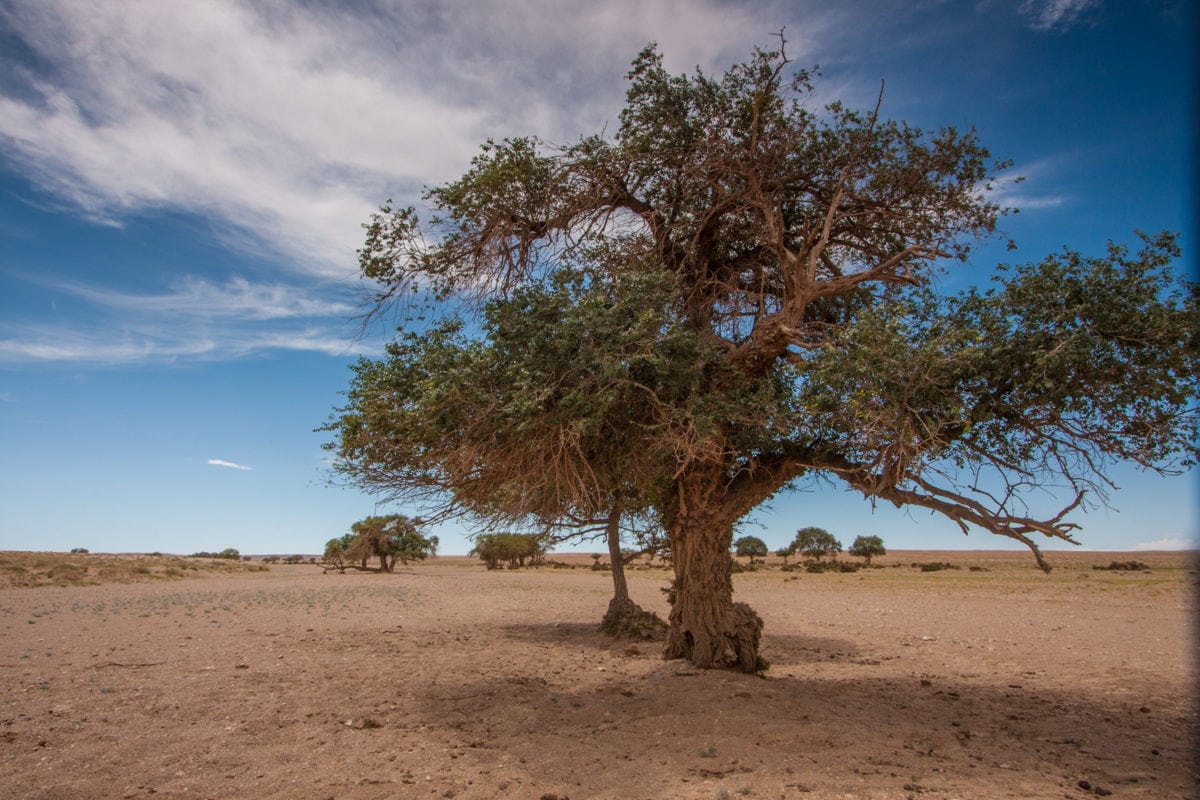
The explainable bunch of hearty trees appeared to be growing next to a dried-out river bed; I imagined these tree roots sucking every last ounce of water out of the river until it was gone and only a slurping sound remained; maybe the Gobi Desert heat was going to my head?
5. Gobi’sEndless Sky
I stared out the window trying to figure out why the Mongolian sky seemed so different; unique and larger than life. After much thought, I came to the conclusion that in NYC or Saigon or most of the places I’ve ever lived, you have to look up to see the sky. You have to make a special effort to view it as it’s normally such a small percentage of our overall view.
However, in the flat, treeless Gobi, the sky was now about 70% of my view and it was straight in front of me. I felt as if I were in one of those round-about theaters where everywhere you looked were clouds. When the sky is constantly within your line of sight, it takes on this vastness that you could feel; and this is what I’ll remember most about the Mongolian landscape.



6. Desert Bones
As if I were on a movie set, we drive and bump our way past rotting animal carcasses, skulls, and various bones scattered on the desert floor. The bones would be so white from the sun that they seemed unreal. In fact, my first reaction to going by what looked to be a yak skull was ‘Is that for real?” As if I thought some movie director had decided to put a fake skull out in the middle of nowhere to create a ‘desert effect’.
These are the times when realize that maybe there has been too much television influence on my life and not enough real-life experiences! Real life in the desert is hard; especially for the animals. These were the animals that didn’t make it for one reason or another.
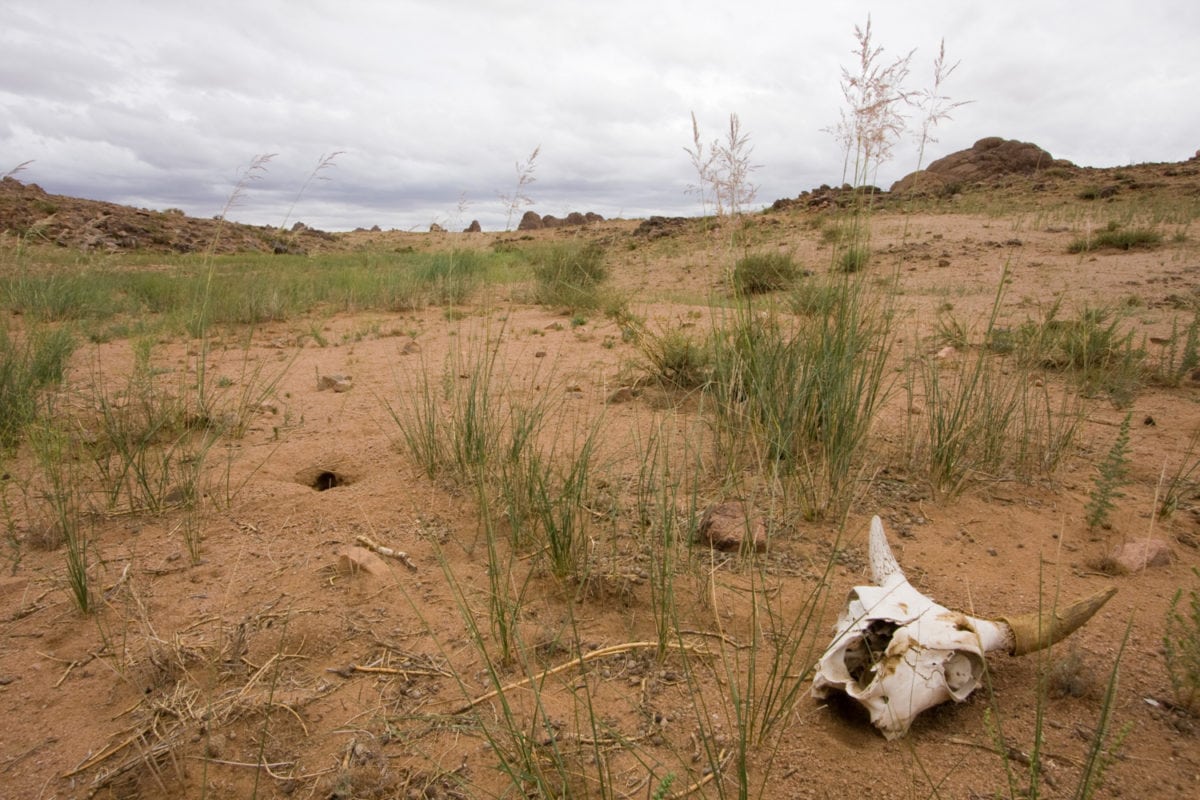
But you can be sure that in the great ‘circle of life’ the other animals benefited from the death as evidenced by the cleanly picked skeletons. One animal’s death was another’s feast.
7. Gobi Desert Queues
Queues don’t exist in Asia. At least that’s what I thought based on the years I had spent traveling around and living in Asia. I thought I was on the right track to prove it when I arrived at the Ulaanbaatar airport and saw the immigration ‘free for all’. A small room with a hundred or so people just in mass pushing their way up front with no regard for queuing. The few tourists, including myself, just sat there dumbfounded but did our best to push our way towards the immigration desk.
However, while driving through the Gobi Desert, my theory was proven wrong! In a desolate land where there are few humans, the animals have seemed to figure out the benefits of queuing!
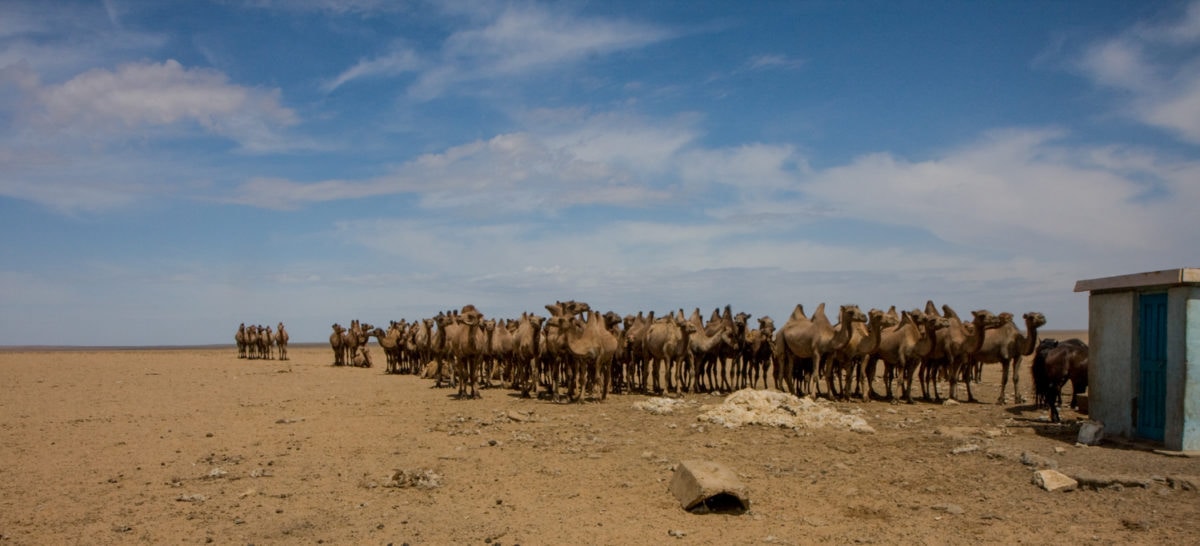
We came across a line of camels and horses at a well. Apparently, a herder must come occasionally and provide them with water, and the animals knew the schedule and had started to queue up. It was one of the most surprising and coolest things I saw in the desert!
Gobi Desert Transportation
During my Gobi Desert travels I experienced all sorts of transportation; some more enjoyable than others. True to the Ger-to-Ger vision, we mainly traveled as the locals did unless we had really far distances to cover. I found the whole experience fascinating as some of the old nomadic ways of travel had evolved into more modern nomadic travel.
Overall, traveling through the Gobi Desert was some of the most difficult and exhausting travel I had ever done; my whole body ached. But whichever way you cross the desert; camel, horse, by foot, cart, motorcycle, bus, or jeep – I can guarantee you it will be an adventure you’ll never forget!
Travel By Local Bus
As soon as we traveled 35 minutes outside of Ulaanbaatar, the pavement disappeared and there was nothing but dirt for the next 12 days. I was honestly surprised and a bit scared when I realized this was it – the end of infrastructure.
The little bubble of infrastructure around Ulanbatar was so small, what in the world was I in for now? The bus now traveled at high speeds along the Mongolian dirt ‘super hi-way’ – a bunch of tracks branching off going every which way like a maze. I was never really sure which one the driver would follow and why, but I had a fun time trying to figure out the logic in a presumably illogical path.
The locals on the bus were unphased by the constant bumps and sways on the uneven ‘hi-way’. In fact, within about 20 minutes the whole bus was sleeping!
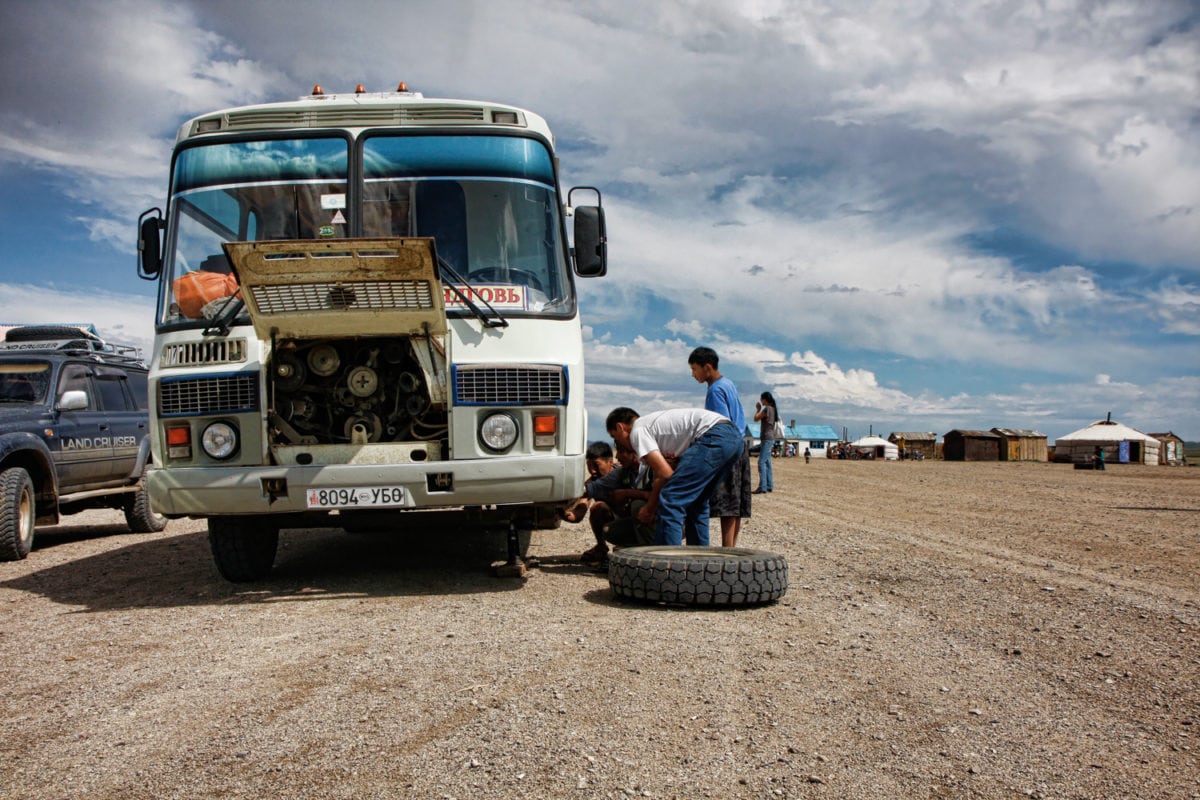
The bus made one stop in a small encampment where everyone piled off the bus and went out into the barren desert and relieved their bladders. This was my first exposure to the Mongolian ‘openness’ (aka kiss privacy goodbye). We were in the desert; there were no trees, no big rocks, no hills – nowhere to hide. I watched women line up about 40 ft. away from the bus squatting and peeing in plain sight. All I could think about was how quickly I would have to shed my own culture to survive in the Gobi Desert.
Travel by Horse Through The Gobi Desert
There’s something notably different about Mongolian horses; unlike the people, they are small. They actually look like the size of ponies. Don’t be fooled by their size though because like everything in Mongolia, they are strong.
I did a 15k horse journey one day in order to arrive at our next local ger and it was full of surprises. To begin with, I was surprised at how small and uncomfortable the saddle was. Mongolians use wooden saddles and like their horses, the saddles are also miniature.
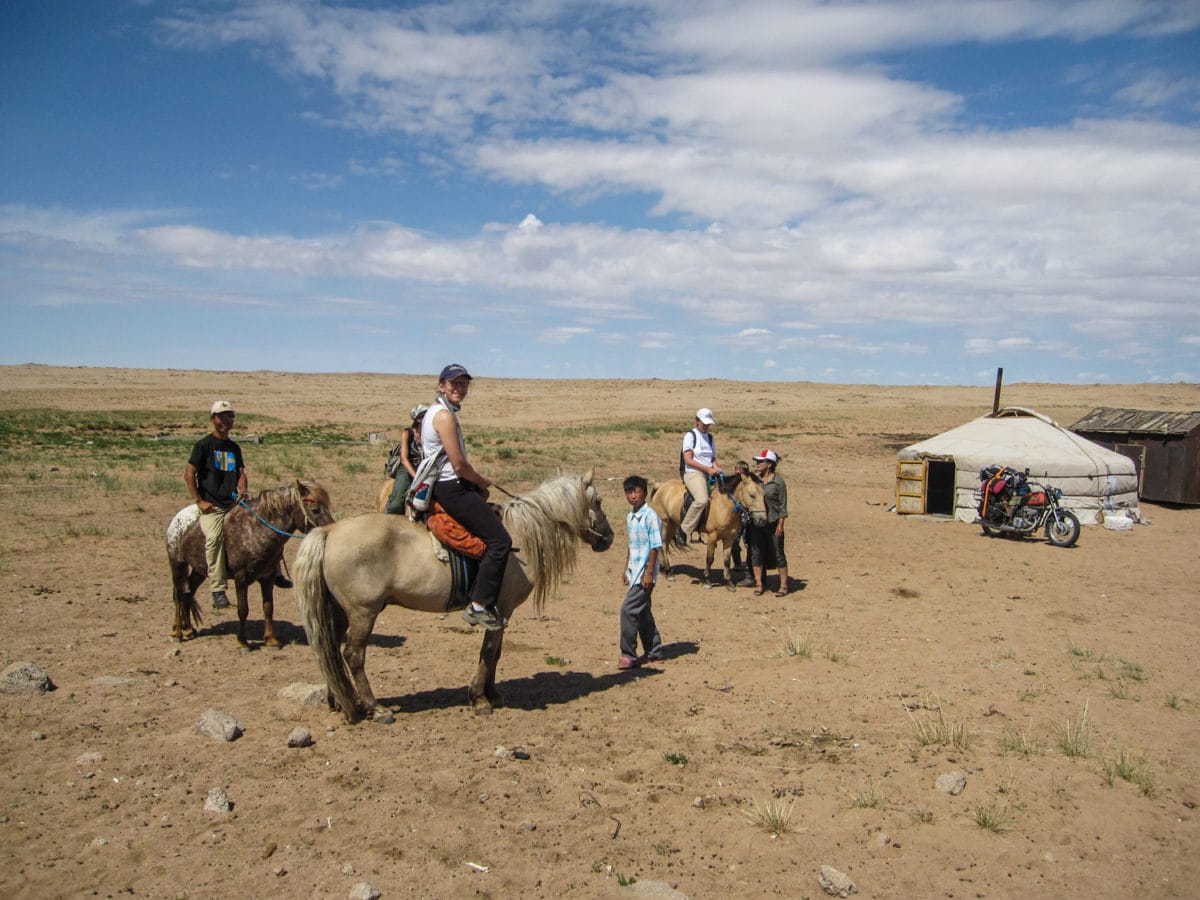
As I took off into the vast Gobi Desert waving goodbye to our last hosts I looked at what was ahead of me – absolutely nothing. Just me, my travel partners, and our Mongolian host trotting through miles and miles of nothing. The only shade we had was provided by the large clouds that would periodically pass overhead.
Riding in extreme nothingness conditions felt surreal; was I really here, or was I dreaming this? Once again, a moment where I had to pinch myself.
Travel by Motorcycle
I didn’t actually ride a motorcycle, however my stuff was frequently transported on a motorcycle by the locals. In fact, the motorcycle was the modern Mongolian herder’s horse. Many times off in the distance I would see animals rounded up by their herder…on a motorcycle. I wondered if John Wayne were still alive and making movies, would he be on a motorcycle now?
Considering the massive distances families sometimes have to travel to get to their ‘neighbors’ or a village, I actually think that having motorcycles is quite a good idea for them.
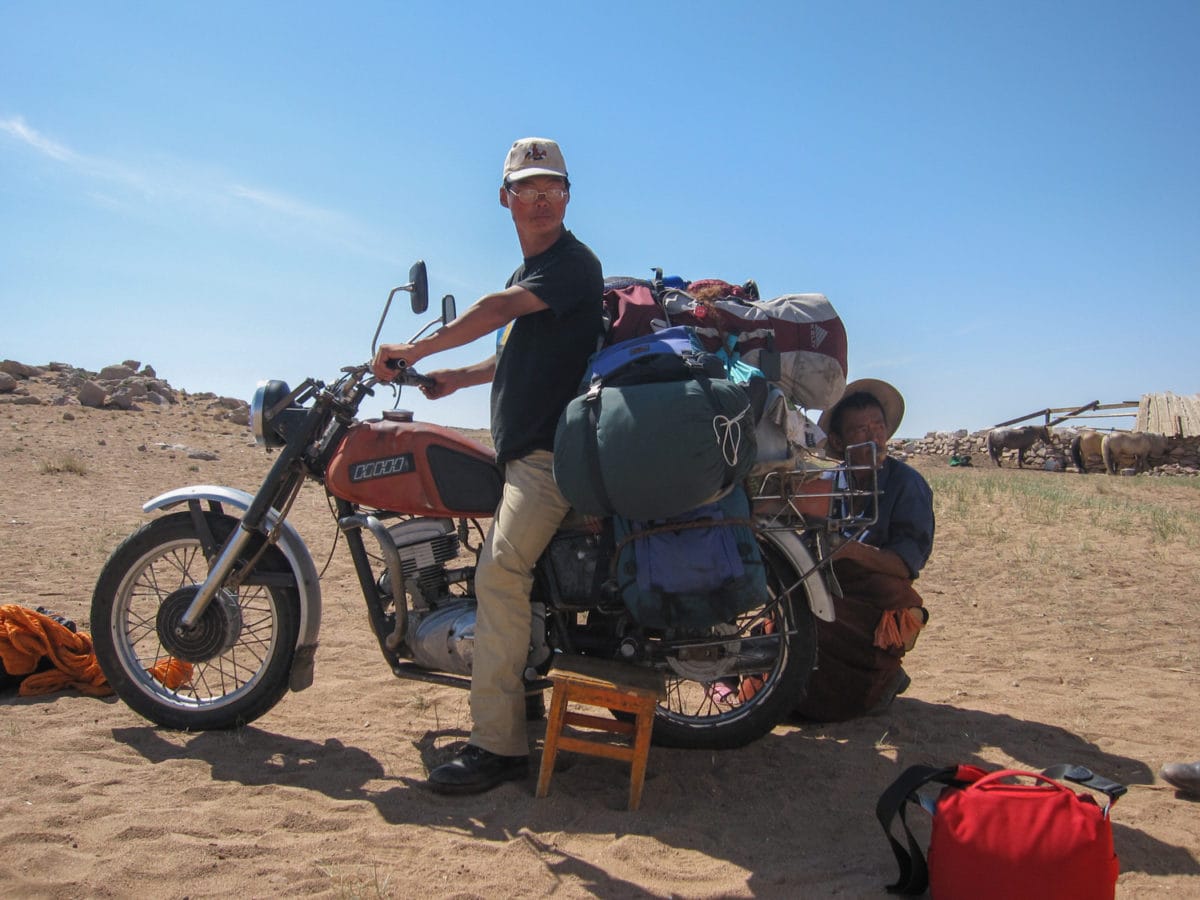
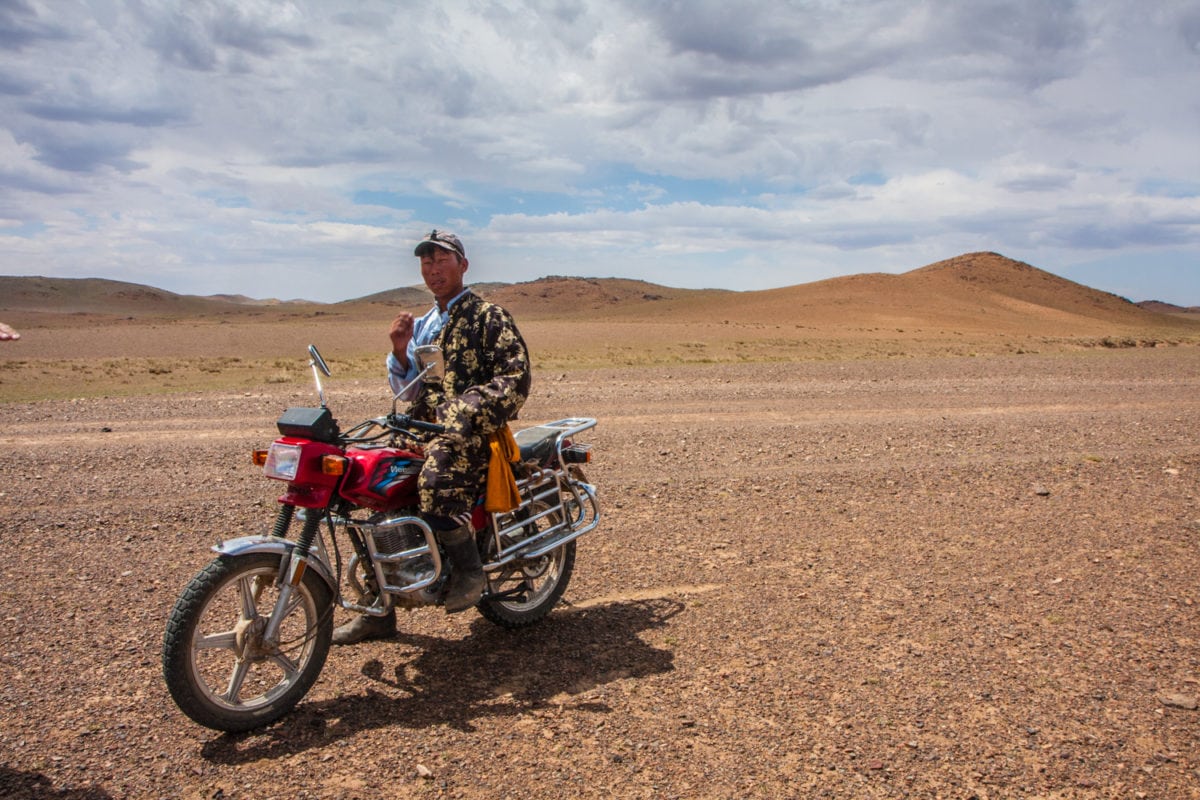
Travel by Camel
Many times the herders would throw all of our bags onto an old wooden cart, with a blanket, place a camel at the front, and off we went to the next ger.
I actually preferred this mode of travel as it was more comfortable than the wooden horse saddle and I was able to take pictures at the same time as we slowly rode across the desert.
However, I’ve never been a huge fan of camels and this trip solidified that feeling. One of the camels we took wasn’t too terribly happy with his duty and decided to ‘doody’ all over our cart and us…projectile camel shit!
Needless to say, we walked the rest of the way while the camel and our hosts slowly rode along without us! I’m positive that this was one of these cultural divides as we walked the remaining 6k and the Mongolians continued to ride on the cart with our luggage wondering why we didn’t find the shit experience as funny as they did.
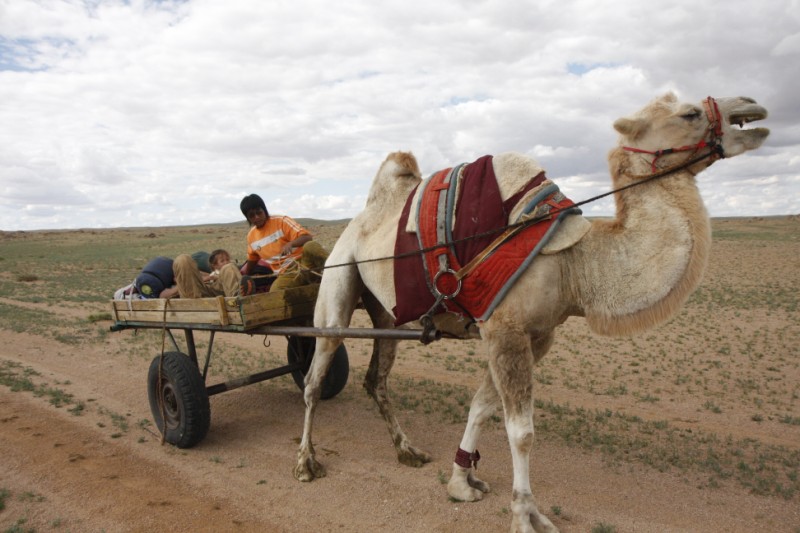
Travel by Private Jeep
Many times we had to cover some pretty massive distances across the Gobi Desert and that’s when we went modern…by Jeep. However, before you get the image of LandRovers or Hummers in your head…let me remind you where we were…Mongolia. We were transported by an old Russian Jeep. It was heavy and resembled a tank and it rode like one too. Many of the jeeps we rode in had padding on the ceiling, for good reason. The jeep rides were long and hard, bumpy, hot, and dirty; but it was better than the camel shit!
Actually, we had a great time in the Jeep. Our driver, Shat (short for Shatarbaatar) was the best. He entertained us by constantly saying he was sorry when he went over a bump that sent us airborne (which was a frequent occurrence), he played Mongolian music and best of all he would stop whenever I wanted a picture or video!
His English was actually better than most of the people we encountered, plus he had a dictionary in his visor always ready at our disposal. We finished our trip by driving 400 km with Shat through the Gobi back to Ulaanbaatar; the scenery was stunning.


Where Can You Find a Mechanic in the Gobi Desert? Everywhere.
I would be amiss if I didn’t mention the Mongolian’s amazing mechanical aptitude. In every form of transportation I mentioned above we had a mechanical glitch at some point or another (I’m counting the camel shit as a glitch).
During my trip – we had 4 flat tires; 2 the first day within 30 minutes of each other! One of our flat tires was actually on the motorcycle transporting our bags and we were on horseback. Here we were, stuck in the desert as our Mongolian hosts did something I’d never seen before; they fixed a flat tire with a piece of shoestring. They found the hole and wound the string so tight around it that it could hold air again. It was a temporary fix, but it allowed us to get back on our horses and be on our way.
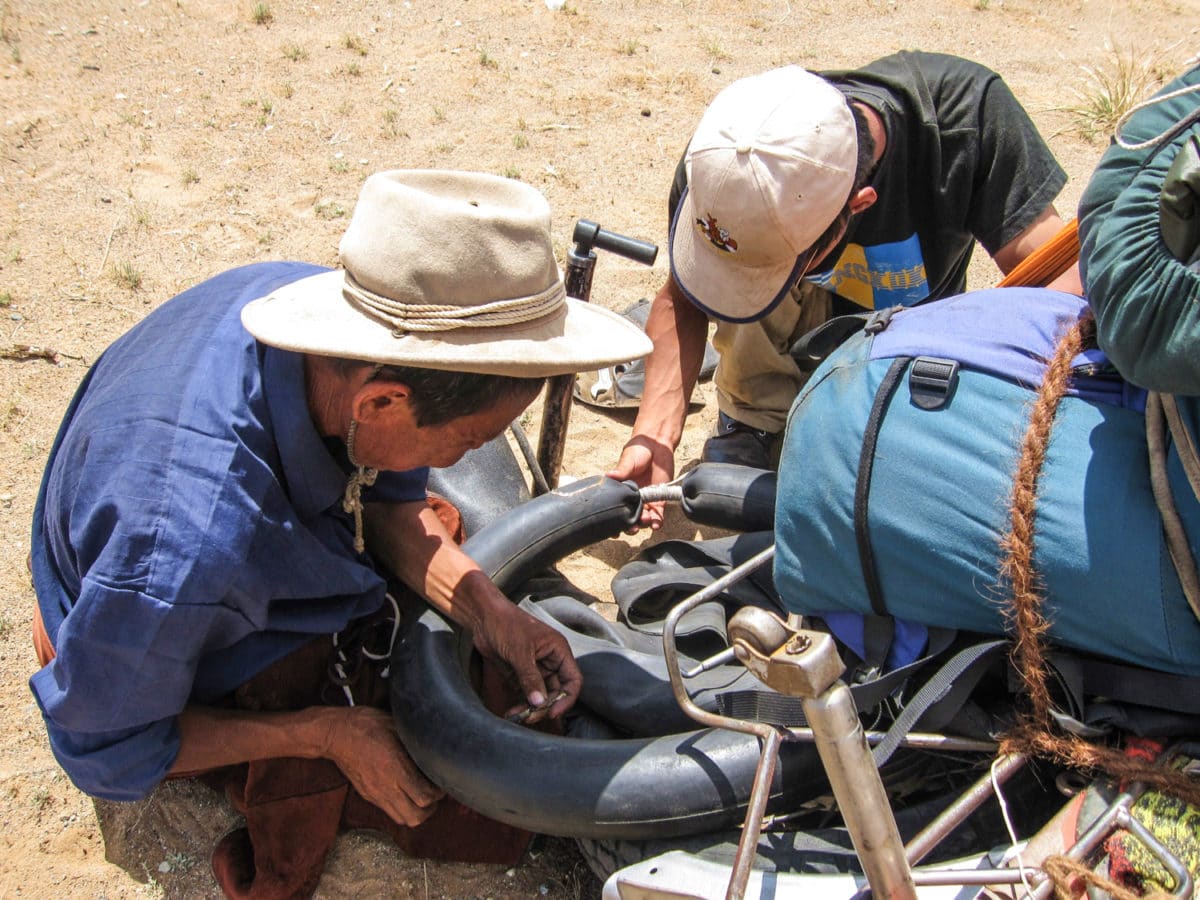
At one point on our way back to Ulaanbaatar, we had mechanical trouble and Shat pulled out this tray of nuts and bolts, disappeared under the hood, and soon we were back on the road. Plus, I loved the fact that Shat carried a roll of duck tape on his gear shift…you never know when you might need to tape the engine together!
Navigating Your Way Through the Desert
In a land with no roads, signs, landmarks, or even a tree I was amazed that we weren’t wandering aimlessly lost in the desert; miraculously our local host always found our destination.
Much like Elmer Fudd hunts for wabbits, we had to hunt for 2 tire tracks going in a direction that was relatively correct (this part was determined by the sun and shadows) I was fascinated with the jeep navigation; we’d be going for 30 km following 2 tire tracks and then we’d suddenly lose them.
We’d zig zag around the desert aimlessly looking for another set to follow. During this time I was normally doing a mental checklist of how much water and food I had with me and if I knew any survival skills for surviving in the desert.
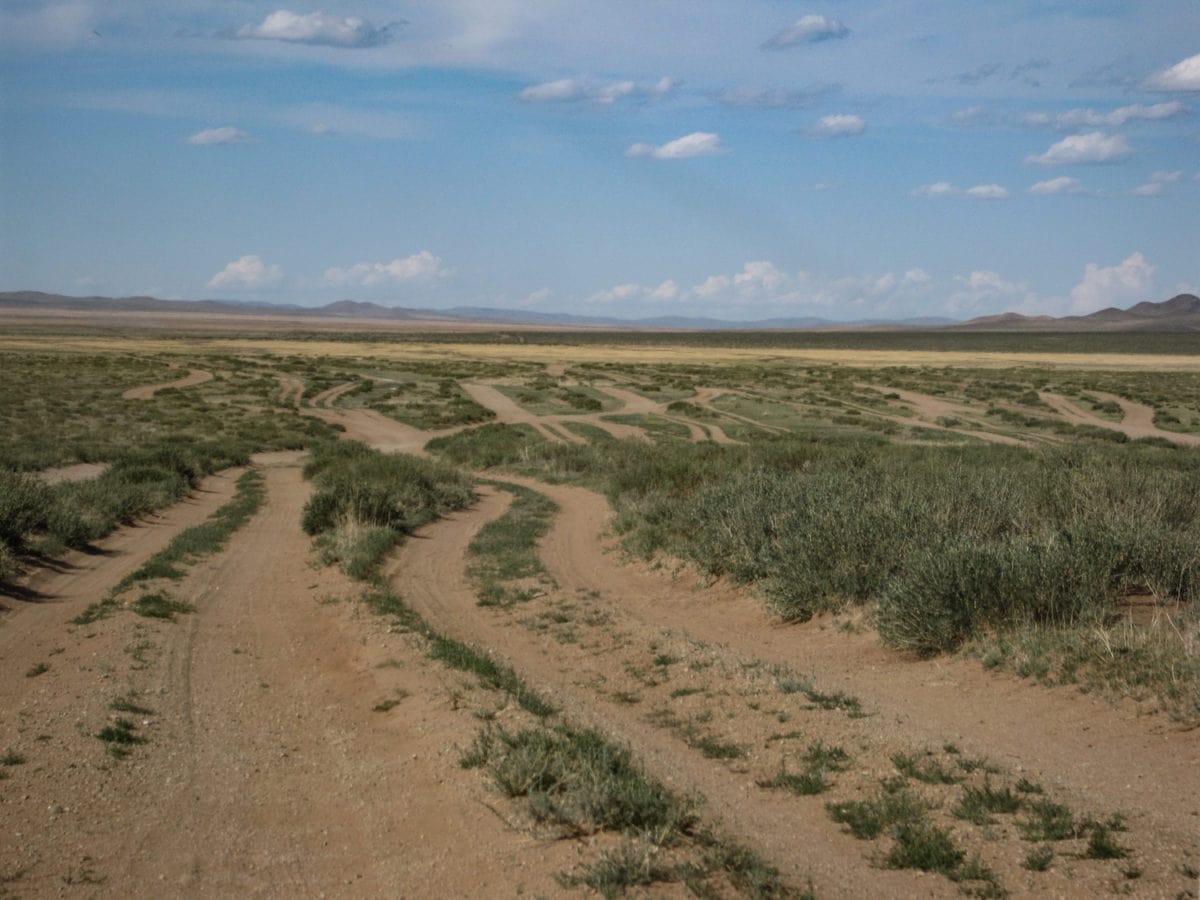
After doing this day after day, I have to admit that I actually got pretty good at finding tracks and pointing them out occasionally to try to help out Shat!
Who would’ve ever thought that 2 years later I’d be driving myself across the Gobi Desert in a race from London to Mongolia! Read about my experience in the Mongol Rally!
Gobi Desert Tour
You might wonder how in the world I experienced all of these surprising things in the Gobi Desert or how I know so much about it. I spent 2 weeks on a Gobi Desert Tour with Ger-to-Ger. It was an in-depth introduction to the people and culture of the Gobi Desert.
Taking a tour is the best way to see the Gobi Desert. The Ger-to-Ger itinerary was very in-depth and put us in direct contact with the locals. We spent 12 days navigating our way through the amazing Gobi Desert landscapes, and I fell in love with it.
Thanks to my travels through the Gobi Desert, Mongolia has always been one of my favorite countries I’ve ever visited. It’s one of the few places you can still go and feel like it’s untouched. Its culture is unique and the people there are welcoming – the perfect combination of what I look for in travel.


By Jodi August 29, 2009 - 6:12 am
Beautiful pics and great post. Thanks for allowing me to linger a little longer in Mongolia.
By bethany August 29, 2009 - 6:25 pm
Amazing Photos! I cannot wait to go to Mongolia. You cannot pay for light that beautiful.
By Stephanie September 1, 2009 - 10:59 am
Great post, Mongolia is one of my dream destinations and your pictures have only intensified that!
By chris September 1, 2009 - 9:32 pm
By far your most interesting and appealing post I have read to date. Thank you! Very inspiring!
By Rebekah September 8, 2009 - 7:27 am
“These are the times when realize that maybe there has been too much television influence on my life and not enough real life experiences”
I think that statement just about sums up what you stand for Sherry! A girlfriend was just working in Venice with one of your countrymen, who on their first day there proclaimed- “Wow, this place looks just like Vegas” and proceeded to declare that Vegas was better because they had aircon and the water was cleaner. All I can say about that is “BRIEFCASE TO BACKPACK PEOPLE- YELL IT FROM THE ROOFTOPS!”
Congratulations on your 3rd anniversary- I’m proud to say I’ve been with you from New Zealand and am still loving your site.
Happy Travels!
By admin September 8, 2009 - 7:58 pm
@Rebekah – ohhhhh – yes you’ve been a long time follower and a now long time friend! That’s the best thing about travel – you form friendships along the way! Thanks for sticking with me – and thanks for holding the pashmina while I peed when we were stuck on the mountain pass in China! Oh, the memories…
By Wanderluster September 10, 2009 - 7:37 am
Really stunning! Mongolia seems to be on everyone’s wish list these days. Must. Get. There. Soon.
By Mark H September 21, 2009 - 2:26 pm
What a wild looking landscape. Your photos give a wonderful sense of isolation and remoteness.
By David Dutton September 22, 2009 - 9:16 am
I really enjoyed the photos. Combined with your description it almost felt as though you were there. I never realized Mongolia was such a beautiful place.
By Amicus Travel Mongolia October 28, 2012 - 12:48 am
Fast building a reputation as one of the must-visit destinations in the world and referred to by many as the earth’s last great wilderness, Mongolia is an endless playground of blue skies, desert sands, rolling taiga and stunning mountains.
If you are visiting Mongolia, make a stop at the Gobi desert. It’s a wonderful place!
By technohills May 19, 2018 - 7:14 am
nice blog thanks for sharing